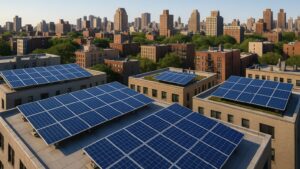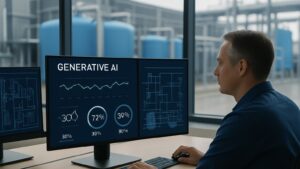Data centres have seen massive growth worldwide. This is with rising global data production and computing needs. Furthermore, the sector’s footprint now represents nearly 1% of global electricity demand. It is even more than most countries. However, poor energy optimization sees the average data centre power usage effectiveness (PUE) languishing at a highly inefficient 1.57. So, as energy comprises over 10% of data centre operating costs, major economic incentives exist to enhance efficiency. AI and machine learning in optimizing data centre offers a tremendous new opportunity in this regard.
These technologies make possible sophisticated analytics, automation, and optimization. That too at a scale and complexity that exceeds human capabilities. By infusing such intelligence into data centre design and operations, step-change improvements in energy efficiency are realizable. This is even as compute densification continues. So let us dive into it more in this article.
AI/ML Innovations Across the Data Centre Energy Stack
Major prospects exist to leverage AI and machine learning in optimizing data centre. It spans demand management, power delivery, and cooling infrastructure. Moreover, on the IT load side, AI facilitates right-sized computing delivery. This is through smart workload scheduling while eliminating resource stranding. Additionally, the electrical chain benefits from automated peak shaving. Meanwhile, facility cooling leverages AI thermal modeling for targeted optimization. So, such local optimizations further compound at the whole facility level.
Let us delve deeper into the diverse applications of AI and ML across the data centre energy landscape for sustainable data centres:
Reimagining Data Centre Monitoring
Continuous surveillance of all critical equipment and environmental factors allows timely detection of impending anomalies. However, the sheer volume of data generated makes adequate real-time analysis nearly impossible manually. AI clustering spots deviations indicative of emerging faults across thousands of data streams. Failures can thus be preempted before causing disasters. This is along with huge energy wastage from associated freeze periods and recovery. It is directly indicative of the power of AI and machine learning in optimizing data centre.
Rebooting Cooling Management
Cooling constitutes over 40% of data centre energy bills due to overprovisioning against peak loads. AI thermal modeling tracks heat flows at high resolution. So, it allows precisely targeted modulation of cooling resources. This is in line with actual local loads. Moreover, matching capacity just in time while eliminating hotspots cuts wastage substantially. Intelligent free-air cooling control also further minimizes chiller usage. Additionally, ongoing ML refinement of thermal patterns allows efficient packing and greater compute density showing the role of AI and machine learning in optimizing data centre.
Reconfiguring IT Systems
Inefficient computing infrastructure represents the biggest data centre energy drain. AI software modernizes IT estate management. This is via smart workload orchestration, storage optimization, and automated server right-sizing. So, by balancing loads dynamically to minimize stranded capacity, resource utilization, and density shoot up while energy bills shrink. Moreover, rightsized power delivery prevents overbudgeting waste. Cybersecure automation also cuts human errors that indirectly impair efficiency.
Realigning Maintenance Strategies
Studies indicate over 25% of data centre outages arise from preventable equipment failures following delayed maintenance. AI predictive algorithms detect early signs of impending breakdowns across assets. As a result, this allows carefully timed preemptive servicing. This is to avoid operational disasters and the huge energy waste from distressed equipment drawing anomalously high power. Moreover, optimal upkeep cycles also maximize equipment lifespan and efficiency.
In totality, these advancements or AI and machine learning in optimizing data centre add up to over 10% PUE enhancements realistically, significantly moving the needle on data centre sustainability.
The AI Energy Efficiency Innovation Landscape
Myriad groundbreaking solutions are maturing across AI and machine learning in optimizing data centre. It is spanning computing optimization, data-driven thermal modeling, predictive infrastructure diagnostics, and energy management analytics.
Global tech giants like Google, Microsoft, Nvidia, and Intel offer advanced cloud-based efficiency tools and hardware. They leverage integrated AI that smaller players can implement faster and more economically than customized development. Moreover, cooling, telemetry, and software startups keep disrupting too. VC funding in these areas exceeded a billion dollars in 2022 alone as the efficiency innovation ecosystem thrives.
Established cooling majors like Schneider Electric, Vertiv, and Stulz have also been quick. This is in infusing ‘baked-in’ AI capabilities across product lines. It ranges from smart in-row coolers to intelligent thermal management solutions. Furthermore, infrastructure automation leaders like Siemens, ABB, and GE offer extensive smart building energy optimization packages. So, the proliferation of sophisticated yet modular AI efficiency enablers makes it easy to leverage these game-changing capabilities.
Realizing The AI Efficiency Dividend
For substantial efficiency gains in practice, piecemeal adoption of disjointed AI tools is insufficient. What is needed is an integrated approach. One that holistically leverages AI and machine learning in optimizing data centre. It should be throughout the end-to-end infrastructure stack. It should also systematically embed ‘smart’ capabilities enterprise-wide. So, this requires upfront investments. However, rapid breakeven from energy savings makes a compelling business case.
The efficiency of AI and machine learning in optimizing data centre journeys necessitates upgrading underlying automation and data architectures. This is in the early phases before deriving full benefits from AI innovation. Moreover, high-fidelity data capture through IoT sensors is vital. ‘Rubbish in, rubbish out’ applies to even the most advanced algorithms. Additionally, strategic roadmaps must balance these modernization imperatives for sustainable data centres. This is by capturing quick-win efficiency use cases to demonstrate proof of value.
Eventually incorporating AI efficiencies becomes a self-reinforcing cycle. This is with energy cost savings funding further digitalization. It unlocks greater savings. By proactively beginning this cycle rather than deferring action, incumbent data centre operators stand to sustainably achieve manifold efficiency at scale. This is while fast movers can build lasting competitive advantage.
Partnership Opportunities To Progress Energy Sustainability
Energy efficiency and emissions mitigation represents both an urgent imperative and substantial opportunity for the data centre industry. This is with growing climate consciousness among governments and investors alike. So, collaboratively exploring AI and machine learning in optimizing data centre tailored to specialized operational contexts allows individual firms to benefit from shared learning.
Industry platforms like the Net Zero Data Centre Summit in Berlin, Germany on 1-2 February 2024 facilitate such partnerships for sustainable data centres. It helps to jointly move ahead on aligned efficiency goals, especially between practitioners and solution experts. So, participation is thus encouraged for all data centre stakeholders. It includes especially the ones seeking to significantly enhance sustainability metrics through holistically integrating appropriate AI innovations while minimizing transition risks. So, make sure you do not miss the opportunity!





